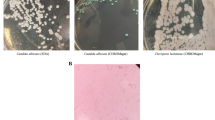Abstract
The most prevalent fungal infection of humans is candidiasis which is caused by species of Candida that are typical members of the commensal microbial flora of the oral mucosa and other body surfaces. Since species of Candida differ in virulence properties and susceptibilities to anti-fungal drugs, understanding the human commensal yeast flora will have a significant impact on designing treatment and prevention strategies against yeast infections. However, although there is a global interest in Candida species, the global distributions of Candida species remain largely unknown, especially among healthy hosts. Here we report the oral yeast flora from the surveys of over 1,000 medical students in China. Our results showed that this population had a yeast carriage rate (4.5%) much lower than other population samples reported previously from Mainland China (40–70%). In addition, C. albicans was isolated at a much higher frequency than those from other Chinese samples, with a frequency (80.9%) more similar to those in developed regions such as North America. The oral yeast carriage rates and yeast species compositions were similar between male and female students and between the hosts borne and raised on Hainan Island and those borne and raised on Mainland China. Furthermore, the sequence variation at the internal transcribed spacer (ITS) regions of the nuclear ribosomal RNA gene cluster was analyzed for strains of the dominant species, C. albicans. Our analysis identified 14 ITS types among the 41 Hainan isolates of C. albicans. However, only four of the 14 ITS types were identical to those in reference strains from Europe and North America. Taken together, our analyses suggest that the oral yeast flora among host populations in China is highly heterogeneous and that there is a high ITS sequence diversity in the Hainan population of C. albicans.
Similar content being viewed by others
References
Odds FC. Candida and candidosis. London: Bailliere Tindall; 1988.
Hazen KC. New and emerging yeast pathogens. Clin Microbiol Rev 1995;8:462–78.
Krcmey V, Barnes AJ. Non-Candida albicans spp. causing fungaemia: pathogenicity and antifungal resistance. J Hosp Infect 2002;50:243–60.
Oliver BG, Silver PM, White TC. Evolution of drug resistance in pathogenic fungi. In: Xu J, editor. Evolutionary genetics of fungi. UK: Horizon Bioscience; 2005. 253–87.
Kleinegger CL, Lockhart SR, Vargas K, Soll DR. Frequency, intensity, species, and strains of oral Candida vary as a function of host age. J Clin Microbiol 1996;34:2246–54.
Okungbowa FI, Isikhuemhen OS, Dede AP. The distribution frequency of Candida species in the genitourinary tract among symptomatic individuals in Nigerian cities. Rev Iberoam Micol 2003;20:60–3.
Kam AP, Xu J. Diversity of commensal yeasts within and among healthy hosts. Diagn Microbiol Infect Dis 2002;43:19–28.
Xu J, Mitchell TG. Geographical differences in human oral yeast flora. Clin Infect Dis 2003;36:221–4.
Sedgley CM, Samaranayake LP. The oral prevalence of aerobic and facultatively anaerobic gram-negative rods and yeasts in Hong Kong Chinese. Arch Oral Biol 1994;39:459–66.
Sedgley CM, Chu CS, Lo EC, Samaranayake LP. The oral prevalence of aerobic and facultatively anaerobic gram-negative rods and yeasts in semi-reclusive human vegetarians. Arch Oral Biol 1996;41:307–9.
Sedgley CM, Samaranayake LP, Chan JC, Wei SH. A 4-year longitudinal study of the oral prevalence of enteric gram-negative rods and yeasts in Chinese children. Oral Microbiol Immunol 1997;12:183–8.
Qi QG, Hu T, Zhou XD. Frequency, species and molecular characterization of oral Candida in hosts of different age in China. J Oral Pathol Med 2005;34:352–6.
Pfaller MA, Houston A, Coffmann S. Application of CHROMagar Candida for rapid screening of clinical specimens for Candida albicans, Candida tropicalis, Candida krusei, and Candida (Torulopsis) glabrata. J Clin Microbiol 1996;34:58–61.
Xu J, Boyd CM, Livingston E, Meyer W, Madden JF, Mitchell TG. Species and genotypic diversities and similarities of pathogenic yeasts colonizing women. J Clin Microbiol 1999;37:3835–43.
Lan L, Xu J. Multiple gene genealogical analyses suggest divergence and recent clonal dispersal in the opportunistic human pathogen Candida guilliermondii. Microbiology 2006;152:1539–49.
Sokal RR, Rohlf FJ. Biometry: the principles and practices of statistics in biological research. 2nd ed. NY: Freeman and Company; 1981.
Pujol C, Dodgson A, Soll DR. Population genetics of ascomycetes pathogenic to humans and animals. In: Xu J, editor. Evolutionary genetics of fungi. Norfolk, UK: Horizon Bioscience; 2005. p. 149–188.
Swofford DL. PAUP*: Phylogenetic analysis using parsimony (and other methods). Sunderland, MA, USA: Sinaur Associates; 2004.
Pfaller MA, Messer SA, Boyken L Tendokar S, Hollis RJ, Diekema DJ. Variation in susceptibility of bloodstream isolates of Candida glabrata to fluconazole according to patient age and geographic location. J Clin Microbiol 2003;41:2176–9.
Xu J, Vilgalys R, Mitchell TG. Lack of genetic differentiation between two geographically diverse samples of Candida albicans isolated from patients infected with human immunodeficiency virus. J Bacteriol 1999;181: 1369–73.
Acknowledgements
We are grateful to all the student volunteers who participated in this study. We thank Lin Yinzi, Zhou Zhenjian, Li Wenguang, Zhang Shufang, Yang Wen, Rao Langyu, and Liu Shan for help in obtaining the Hainan samples. We also thank Drs. David Soll and Claude Pujol for sharing their reference strains. This research was supported by grants from Hainan Medical College, the Natural Science and Engineering Research Council (NSERC) of Canada, the Premier’s Research Excellence Award (PREA) of Ontario, and the National Science Foundation of China (grant no. 30628002).
Author information
Authors and Affiliations
Corresponding author
Rights and permissions
About this article
Cite this article
Wang, H., Wang, Y., Chen, J. et al. Oral yeast flora and its ITS sequence diversity among a large cohort of medical students in Hainan, China. Mycopathologia 164, 65–72 (2007). https://doi.org/10.1007/s11046-007-9028-5
Received:
Accepted:
Published:
Issue Date:
DOI: https://doi.org/10.1007/s11046-007-9028-5




